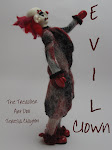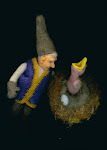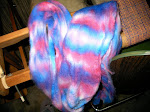First picture above: I prepped 5 different colors of wool using my small, Louet drum carder. I carded the colors side-by-side as I did not want them to all blend together.
Above: This is a picture of the pre-drafted fibers. Keeping the colors separate I gently thinned the batt by pulling the fibers into a long, wispy roving. I did this very carefully to keep an even distribution of color. Now I have nice thin layers of multi-color wool for wet felting. This is about 1/2 oz of total fiber. I'll reserve a portion of this roving for spinning a matching yarn to finish the vessel.
The above picture is all that is needed for wet felting other than water and your own two hands. Here you see the wool blend, diluted Dawn dish liquid, and a small plastic lotion container that will be used to support the wool as it is felted.
Above: The first layers of wool gently layed over the plastic container. (I did not take pictures of the subsequent layers but two more were applied until the jar was completely enclosed in wet, colorful wool.) I criss-crossed the fiber layers and then gently rubbed the wet, sudsy wool until it all began to felt together. It is initially important to be very careful to not displace the fibers. You will be rubbing over them. Eventually all the individual fibers will slowly felt together into a solid wool fabric. (Scroll down to my previous post for a better explaination and how to incorporate the use of hot and cold water to speed the process.)
The above picture shows the finished felted portion. I cut a hole in the top of my felted fabric to remove the lotion jar then continued wet felting until the vessel became strong, thick and smaller than the jar. The leftover roving was used to spin and ply a thin yarn for crocheting around the top of my vessel.
And above is the finished piece. The small background picture is of this same project beside a smaller vessel that was made by wet felting over a golf ball. I like the effect of using a variety of colors when felting this way.
I prefer to felt smaller projects but extremely large vessels can be created using this same process.



































1 comment:
Nothing to do with felting. I thought I'd lost you or that you had dissappeared. I located you last fall through (I think) Yarn Harlot and I was entranced by your creations, especially the rooster. Consequently I bokmarked your blog, but everytime I checked it I was still looking at a goldfish washcloth. I have nothing agaist goldfish, but I was beginning to think that you had stopped blogging. Suddenly it registered to me that the little list at the side of the page showed entries for 2010. Turns out that dummy here had bookmarked your September blog and not the site! Now I can follow! Thanks for the fun!
Post a Comment